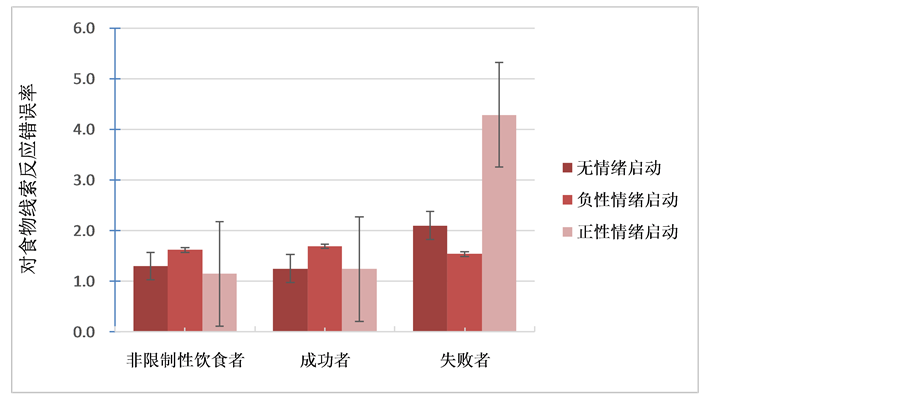1. 引言
当今时代,以瘦为美已变成主流。为了追求这种美,很多人努力的将自己的体重降低并且长期维持,从而符合这种美所要求的体形,尤其是女性居多。另一方面,2004年美国肥胖率竟比1980年高出两倍多(Ogden et al., 2006)。所以除了对美丽的追求以外,肥胖是导致人们对降低体重的需求的一个原因。虽然很多人尝试通过限制饮食来控制他们的体重,从长远来看大部分都失败了(Mann et al., 2007)。一项对美国国家体重控制注册中心中6000人进行的调查研究,将成功的体重控制定义为减轻10%的体重并且维持这个体重超过一年(Thomas, Bond, Hill, & Wing, 2011)。但是,我们无法从控制体重方法技术中了解成功节食的心理机制(Stroebe, van Koningsbruggen, Papies, & Aarts, 2013)。
Herman & Mack (1975)提出限制性饮食概念。日常生活中,限制性饮食者等暴食症者相比于神经性厌食者(Pazfilho & Licinio, 2009)更为普遍,且数目更加庞大,更值得饮食行为管理研究和肥胖心理学研究关注(翁春燕,陈红,&朱岚,2012)。
1.1. 限制性饮食
限制性饮食由Herman和Mack (1975)提出并将其定义为,为了降低和维持体重而对热量摄入进行限制的有目的性的行为(Herman & Mack, 1975; Wadden, Brownell, & Foster, 2002)。虽然以往研究者对限制性饮食的界定各有侧重,在表述上也不尽相同,但综合来看,限制性饮食者存在以下特点:1) 首先就目标而言,限制性饮食者控制饮食的目的主要是降低和维持体重;2) 其次,限制性饮食者对进食的控制是长期的,而且具有认知的特征;3) 限制性饮食者对饮食的限制除了降低或者是维持较低的进食量,还表现为避免或减少高热量食物摄入;4) 并且在女性中更为常见(孔繁昌 et al., 2011)。因此,本研究将限制性饮食界定为,为了控制体重而长期严格控制进食的倾向。故限制性饮食者就是以控制体重为目的,长期严格地控制进食的个体。
限制性饮食者是否能够维持一个低热量摄入状态的证据还不统一(Lowe, 1993; Tepper, Trail, & Shaffer, 1996)。限制性饮食者不仅自身体重不稳定,而且最重时的体重常常高过非限制性饮食者(Stice, Davis, Miller, & Marti, 2008)与限制性饮食的行为相违背的是,有些限制性饮食者会出现过量进食的倾向或是解脱性饮食。解脱性进食常常发生在一些进食过高热量食物的限制性饮食者(Polivy, 1976)或者正在经历焦虑(Heatherton, Herman, & Polivy, 1991)或紧张的限制性饮食者中(Polivy & Herman, 1999)。但是正如上面所说的,并不是所有的限制性饮食者都不能很好控制自己的饮食行为。限制性饮食者可分为两类——成功者和失败者。成功的限制性饮食者在高限制性倾向同时有降低进食量的特点,而失败的限制性饮食者虽然限制倾向很高,进食倾向也很高(Strien & Ouwens, 2007)。
目前对限制性饮食者进行筛选釆用的测量工具主要是限制性饮食量表(Restrained Scale, RS)、荷兰人饮食行为问卷(The Dutch Eating Behavior Questionnaire, DEBQ)和三因素饮食问卷(Three Factor Eating Questionnaire, TFEQ)。三个量表各有所侧重,有研究表明RS测量的更多是失败的限制性饮食者, DEBQ和TFEQ则更多测量的成功的限制性饮食者(Stice, Sysko, Roberto, & Allison, 2009)。
1.2. 情绪对限制性饮食的影响(边界模型)
情绪作为一个独特的激发功能,对人和动物的基本行为进行控制(Izard & Ackerman, 2000)。从进食动机、对食物的反应、选择、下咽、进食速度、摄取量(Greeno & Wing, 1994)到消化吸收的整个进食过程都受到一些具有弥散性和持久性的情绪的影响(Greeno & Wing, 1994; Wing, Blair, Epstein, & Mcdermott, 1990; Blair, Wing, & Wald, 1991; Willner & Healy, 1994; Macht & Simons, 2000)。大部分的人都有为了应对压力而进食的经历(Oliver & Wardle, 1999)。对同一情绪而言,可能会增加一部分人的食物摄入,但却会降低另一部分的。而对于同一人群而言,不同情绪对其进食量的影响增减不一。例如无聊状态会增加进食量而悲伤则会减少进食量(Koball, Meers, Storferisser, Domoff, & Mushereizenman)。这种在个体和情绪之间的双向可变性在以往的研究中常常被忽视(Van Blyderveen et al., 2016)。
失败的限制性饮食者为了达到减肥或控制体重的目的,长期反复节食却经常遭遇失败。由此产生身体疾病如贪食症、神经性厌食症或肥胖症等,以及心理障碍诸如焦虑、抑郁等。这种情况非常常见,因此饮食领域的研究者们从很早便开始探索个中缘由。情绪便是研究者们的关注点之一,并提出了种种情绪影响饮食的模型,如有Herman等(1984)提出的边界理论,Boon和Strobe等提出的有限能力理论,Stice等提出的情绪管理模型等。
其中,Herman (1984)等提出的边界理论(Boundary Theory of Eating)至今仍被认为是饮食认知管理中最重要的理论之一。该理论假设两条生理界限(饥饿边界和饱足边界)将我们的感觉分成三个区域:饥饿、饱足和生物学的中立边界。在这三个区域中无论是饥饿还是饱足都是令人不舒服的厌恶区域。正常人会通过控制进食与否以及进食量,来使自己维持在舒适的生物学的中立边界,即根据自己的生理线索来决定进食。但是限制性饮食者为了降低体重或者维持体重,会为自己强行设定一个节食边界,由此来控制进食量以及进食内容,从而达到降低或维持体重的目的(如图1)。由于该理论认为对饮食行为的认知管理是一个控制的过程,并且这个节食边界是需要消耗大量认知资源来维持的。当负性情绪出现时,大量的认知资源就会被先用于处理当前紧急的情绪状况,致使节食边界变得岌岌可危。由于频繁地节食,并且在停止节食后又过度进食,导致他们对身体的饥饿、饱足信号愈加迟钝,反而对外部食物线索更加敏感。相比内部信号,他们对外部食物线索更加敏感。过去,己有大量关于的研究。一般常采用观看负性电影或图片、回忆负性经历(negative autobiographical experiences)、阅读Velten负性自我参照状态(Velten-self referent statements)、参加公共演讲、人际排斥(interpersonal rejection)、等待抽血等方法诱发负性情绪后,检测限制性饮食者和非限制性饮食者进食行为的差异(Stroebe et al., 2013)。大部分研究发现,负性情绪增加限制性饮食者的进食量(Mm & Hetherington, 2004; Polivy & Herman, 1999 ; Ruderman, 1986; Herman & Mack, 1975)。但也有少部分研究没有发现限制性饮食者在负性情绪后进食量增加(Oliver, Wardle, & Gibson, 2000; Heatherton, Herman, & Polivy, 1991)。而如上所说,成功和失败的限制性饮食者在认知和行为

Figure 1. The boundary model of eating
图1. 饮食调节的边界模型
方面都有着很大的差异。所以出现这种不统一的结果,可能是因为他们没有将限制性饮食者中的成功和失败的限制性饮食者这两个亚类区别讨论。
1.3. 行为抑制控制及Go-Nogo研究范式
行为抑制控制,是指在特定环境下监控和抑制不恰当行为,与个体生存适应等密切相关(Yuan, Yang, Meng, Yu, & Li, 2008; Albert, Lópezmartín, & Carretié, 2010; Fuster, 2000; Li, Huang, Constable, & Sinha, 2006)。日常的生活中,由于对外部世界产生了一些固有认知,我们就会对某些刺激和线索习得了一些特定的反应,这种反应就是优势反应。当我们面对一些突发情况或陌生环境,这些以往的知识经验不再适用,就需要我们抑制已经产生的优势反应,从而使我们的行为与场景匹配。处于现代社会的人,想要取得成功必须要做出正确的决策以及控制错误行为的发生,而行为控制能力在这两者中扮演者至关重要的角色,行为控制能力缺失或异常冲突是冲突或犯罪的重要原因之一(Bjorklund & Shackelford, 1999; Li, Huang, Constable, & Sinha, 2006)。作为执行功能系统中的核心成分,行为抑制控制在预防过度进食上发挥着重要的作用(Nederkoorn, Smulders, Havermans, Roefs, & Jansen, 2006)。
目前,被广泛用于研究个体对知觉刺激进行抑制控制的实验范式主要有:Go-Nogo任务(Elliott, Rubinsztein, Sahakian, & Dolan, 2000)、Stop-Signal任务(Dimoska, Johnstone, & Barry, 2006)和双选Oddball任务(Wang et al., 2011)。Go-Nogo任务的实验逻辑是:通过操纵不同刺激类型的trial数(25% VS 75%),使需要做出反应的那种刺激成为优势反应(Dillon & Pizzagalli, 2007)。当另一种小概率刺激类型出现时,则要求他们抑制先前的反应冲动。因为在任务中被试对Nogo刺激进行加工时包括了行为抑制控制过程,但对Go刺激加工时不包括。所以两者在行为和神经上的差异就标志着抑制控制效应(辛勇,李红,&袁加锦,2010)。
1.4. 问题的提出
研究者认为情绪是导致限制性饮食者节食失败的原因之一。根据边界理论,消极情绪能破坏限制性饮食者管理进食的能力,打破他们的节食边界使其不再坚持节食,并最终导致过度进食和体重增加。但是并非所有的限制性饮食者都会节食失败,部分群体能很好地管理自己的饮食行为从而成功控制体重。这部分群体可以通过DEBQ量表筛选出来,如高限制低去抑制性饮食倾向即为成功的限制性饮食者,他们通过节食能成功达到减肥或保持体重的目标;而高限制高去抑制性饮食倾向则是失败的限制性饮食者,他们希望通过节食而减肥但结果往往不尽如意。
因此,本研究旨在考察情绪对成功和失败限制性饮食者抑制控制能力的影响是否有差异。若有差异,这种差异是在两种亚类的一般性的抑制控制能力,还是只针对食物线索的抑制困难。以往的研究大部分只考察了消极情绪对两种亚类的影响。本研究补充了前人这一空缺,同时还讨论了积极情绪和阈下情绪对限制性饮食的影响。
2. 实验一
2.1. 实验目的
实验一使用Go-Nogo范式探测三类被试(非限制性饮食者、成功的限制性饮食者和失败的限制性饮食者)在不同的情绪启动下(正性、负性和无启动),对不同线索(食物线索和非食物线索)的抑制控制能力。根据边界理论,负性情绪降低失败的限制性饮食者对食物线索的抑制控制能力;而对成功的限制性饮食者和非限制性饮食者的抑制控制能力无影响。
2.2. 被试
通过西南大学内部招募获得被试。所招募的被试首先要:无任何急(慢)性身体及精神疾病;无吸烟、吸毒及酗酒史;非饮食失调且无饮食失调历史;视力正常或矫正视力正常(孔繁昌 et al., 2011)。
实验前使用荷兰人饮食行为问卷(The Dutch Eating Behavior Questionnaire, DEBQ)对被试进行筛选,符合筛选要求的方可参加实验。根据前人的标准:DEBQ_R < 16认定为非限制性饮食者;DEBQ_R > 27,DEBQ_EM < 30,DEBQ_EX < 30且进行体重控制的时间超过6个月,认定为成功的限制性饮食者;DEBQ_R > 27,DEBQ_EM > 30,DEBQ_EX > 30且进行体重控制的时间超过(包含) 6个月,认定为失败的限制性饮食者(孔繁昌 et al., 2011)。最后我们从300名被试中筛选出54名体重在正常范围内(BMI = 18.5~23)的女生(Oliver & Wardle, 1999)。平均年龄为:M = 20.3 ± 1.6 (周岁)。基本信息见表1。
2.3. 仪器和材料
本研究采用由Van StrienFrijtersBergers和Defares编制荷兰人饮食行为问卷(The Dutch Eating Behavior Questionnaire, DEBQ)区分被试。DEBQ总共有三个份问卷:情绪性进食(emotional eating)、外部性进食(external eating)以及限制性进食(restrained eating)三个分问卷,共33个项目1~5五点记分。该问卷信度和效度良好,三个分问卷的内部一致性系数分别为情绪性进食(DEBQ_M) 0.95;外部进食(DEBQ_E) 0.81;限制性进食(DEBQ_R) 0.95 (Oliver & Wardle, 1999; Rotenberg & Flood, 1999)。是现在国内公认信效度良好且广泛运用的量表。
采用改编视觉模拟情绪量表(Visual Analogue Mood Scales, VAMS),让被试在1~100程度等级上选择一个数字代表当前的状态,从而测量被试焦虑、抑郁、困倦、放松、高兴和警觉程度,量表信效度良好。用同样的方法改编视觉模拟量表(Visual Analogue Sales, VAS)测量被试饥饿程度。
本文使用巴赫的“勃兰登堡协奏曲”来诱发正性情绪;使用巴伯的“弦乐柔板”诱发出悲伤情绪。在诱发这两种情绪上,这两首曲子已经得到了广泛的共识(Krumhansl, 1997; Peretz, Gagnon, & Bouchard, 1998; Baumgartner, Esslen, & Jäncke, 2006)。
实验中的材料选自标准化的食物图片库(Kong, Yan, & Hong, 2015)作为靶刺激图片。其中60张中性图片(矿泉水和沙发)和120张食物图片。图片均经过标准化的处理,大小统一为500 × 275像素,图片背景为白色,置于屏幕正中间。每张图片都使用Photoshop进行全图描边处理,边框大小统一。所有刺激都在银色背景上呈现在屏幕中央。

Table 1. Describe statistics of basic information among three groups (M ± SD)
表1. 三组被试的基本信息描述统计表(M ± SD)
注:BMI (体型指数) = 体重(kg)/身高2 (m2);DEBQ_R = 限制性饮食;DEBQ_EM = 情绪性进食;DEBQ_EX = 外部性进食。
实验程序使用E-prime软件编程。结果使用SPSS1.7进行统计分析。
2.4. 实验设计
采用3 (被试类型,非限制性饮食者/成功的限制性饮食者/失败的限制性饮食者) × 3 (情绪启动,无启动/负性情绪启动/正性启动) × 2 (线索,食物图片靶刺激/非食物图片靶刺激)混合设计。
被试类型作为被试间变量,其它则为被试内变量。因变量为被试在Nogo情况下错误反应率。
2.5. 实验程序
实验开始前向被试简单介绍实验流程及相关注意事项,被试签署知情同意书。实验操作均在计算机上进行,在个体实验室单独完成。
首先用VAS和VAMS对被试的饥饿程度和情绪状态做基线评定。然后完成情绪启动:听着主试提供的积极/消极音乐(勃兰登堡协奏曲/弦乐柔板),同时回忆起记忆中最开心/悲伤的一件事以及当时的感受,并写在纸上。中性情绪则让被试静坐3分钟。
正式试验开始时,首先屏幕中间将出现800毫秒的注视点。接着将会出现一张带有边框的图片,要求被试对边框颜色进行反应。若边框为绿则按“B”键进行反应(Go);若边框为红色则不做任何反应(Nogo)。若被试没有在800毫秒内反应则自动跳过。最后是400毫秒的空屏(如图2)。
实验共有三个Block,每个Block中有120个trial。其中75%的trial为Nogo任务,25%的为Go任务。每个Block之间都有足够的休息时间以及其他无关任务让被试进行调节。
2.6. 结果
所有被试反应的正确率都达到80%以上。并且Go反应时都大于200毫秒,保留所有数据进行一步的分析(见表2)。
对三类被试的饱足感、焦虑、抑郁、困倦、放松、高兴和警觉程度分别进行单因素方差分析分析,结果显示三类被试在这七项中差异都不显著(见表3)。表明实验开始前被试的饱足感和情绪不是影响三类被试在各种实验处理下的因素。

Figure 2. The flow diagram of single trial in experiment 1
图2. 实验一中单个trial的流程图

Table 2. Descriptive statistics of experiment 1
表2. 实验一描述统计表

Table 3. The variance analysis results among three groups’ statement
表3. 三类被试状态的方差分析结果
分别做被试对食物线索和非食物线索反映错误率3 (被试类型:成功/失败/正常) × 3 (情绪启动:正性/负性/中性)重复测量方差分析。对食物线索反应时,被试类型、情绪启动和交互作用显著,F(2,53) = 5.974,p = 0.005;F(2,53) = 19.079,p < 0.001;F(2,53) = 8.088,p < 0.001。进一步简单效应分析结果显示,成功的限制性饮食者在中性、负性、正性三种情绪启动下对食物线索反应的错误率无显著差异,t(12) = −0.887,p = 0.392;t(12) = 0.443,p = 0.666;t(12) = −0.197,p = 0.861。失败的限制性饮食者和非限制性饮食者在负性情绪启动下对食物线索反应的错误率都显著高于中性情绪和正性情绪,t(19) = 5.286,p < 0.001;t(19) = 5.241,p < 0.001;t(19) = 2.286,p = 0.034;t(19) = 2.430,p = 0.025;而正性情绪和中性情绪无显著差异,t(19) = −0.252,p = 0.803;t(19) = −0.271,p = 0.789 (见图3)。

Figure 3. The error rate in three groups under food cues condition
图3. 在食物线索条件下三类被试的错误率
对非食物线索反应时,情绪类型显著,F(2,53) = 8.534,p < 0.001;被试类型和交互作用不显著,F(2,53) = 0.064,p = 0.938;F(2,53) = 0.177,p = 0.950。事后检验发现,负性情绪启动下被试对非食物线索反应错误率显著高于中性和正性情绪,t(53) = 3.395,p = 0.001;t(53) = 3.855,p < 0.001;而正性情绪启动下和中性下则无显著差异,t(53) = 0.171,p = 0.865。
3. 实验二
3.1. 实验目的
实验二通过Go-Nogo的实验范式,探讨阈下情绪启动对三种饮食者不同线索下的抑制控制的影响。同样预测阈下情绪启动降低失败的限制性饮食者对食物线索的抑制控制能力;而对成功的限制性饮食者和非限制性饮食者的抑制控制无影响。
3.2. 被试
通过西南大学内部招募获得被试。所招募的被试首先要:无任何急(慢)性身体及精神疾病;无吸烟、吸毒及酗酒史;非饮食失调且无饮食失调历史;视力正常或矫正视力正常。
实验前使用同实验一相同的标准从300名被试中筛选出54名体重在正常范围内(BMI = 18.5~23; Choo, 2002)的女生。基本信息见表4。
3.3. 仪器和材料
本研究采用由Van StrienFrijtersBergers和Defares编制荷兰人饮食行为问卷(The Dutch Eating Behavior Questionnaire, DEBQ)区分被试。
采用改编视觉模拟情绪量表(Visual Analogue Mood Scales, VAMS),让被试在1~100程度等级上选择一个数字代表当前的状态,从而测量被试焦虑、抑郁、困倦、放松、高兴和警觉程度,量表信效度良好。用同样的方法改编视觉模拟量表(Visual Analogue Sales, VAS)测量被试饥饿程度。
实验中的材料选自标准化的食物图片库(孔繁昌 et al., 2011)作为靶刺激图片。其中60张中性图片(矿泉水和沙发)和120张食物图片。图片均经过标准化的处理,大小统一为500 × 275像素,图片背景为白

Table 4. Describe statistics of basic information among three groups (M ± SD)
表4. 三组被试的基本信息描述统计表(M ± SD)
注:BMI (体型指数) = 体重(kg)/身高2 (m2);DEBQ_R = 限制性饮食;DEBQ_EM = 情绪性进食;DEBQ_EX = 外部性进食。
色,置于屏幕正中间。每张图片都使用Photoshop进行全图描边处理,边框大小统一。所有刺激都在银色背景上呈现在屏幕中央。
实验中使用的情绪启动图片全部取自中国化面孔情绪图片系统(黄宇霞&罗跃嘉,2004)。入选的图片有80张中性图片、80张负性图片和80张正性图片。黑白图片,背景为黑色。经过标准化处理后,260 × 300像素,均呈现在银色背景上呈现在屏幕中央。
实验程序使用E-prime软件编程。结果使用SPSS1.7进行统计分析。
3.4. 实验设计
与实验一相同,采用3 (被试类型,非限制性饮食者/成功的限制性饮食者/失败的限制性饮食者) × 3 (情绪启动,无启动/负性情绪启动/正性启动) × 2 (线索,食物图片靶刺激/非食物图片靶刺激)混合设计。
被试类型作为被试间变量,其它则为被试内变量。因变量为被试在Nogo情况下错误反应次数。
3.5. 实验程序
实验开始前向被试简单介绍实验流程及相关注意事项,被试签署知情同意书。实验操作均在计算机上进行,在个体实验室单独完成。所有刺激都在银色背景上以白色呈现在屏幕中央。用VAS和VAMS对被试的饥饿程度和情绪状态做基线评定。
正式试验开始时,首先屏幕中间将出现800毫秒的注视点。接着将会呈现一张情绪图片,时间为20毫秒。图片消失后会立即出现一张带有边框的图片,要求被试对边框颜色进行反应。若边框为绿则按“B”键进行反应(Go);若边框为红色则不做任何反应(Nogo)。若被试没有在800毫秒内反应则自动跳过。最后是400毫秒的空屏(如图4)。
实验只有1个Block,共240个trial。其中75%的trial为Nogo任务,25%的为Go任务。
3.6. 结果
所有被试反应的正确率都达到80%以上。并且Go反应时都大于200毫秒,保留所有数据进行下一步的分析(见表5)。
对三类被试的饱足感、焦虑、抑郁、困倦、放松、高兴和警觉程度分别进行单因素方差分析分析,结果显示三类被试在这七项中差异都不显著(见表6)。表明实验开始前被试的饱足感和情绪不是影响三类被试在各种实验处理下的因素。
分别做被试对食物线索和非食物线索反映错误率3 (被试类型:成功/失败/正常) × 3 (情绪启动:正性/负性/中性)重复测量方差分析。对食物线索反应时,被试类型、情绪启动和交互作用显著,F(2,53) = 2.784,p = 0.0.071;F(2,53) = 12.103,p < 0.001;F(2,53) = 7.045,p < 0.001。进一步简单效应分析结果显示,成

Figure 4. The flow diagram of single trial in Experiment 2
图4. 实验二中单个trial的流程图

Table 5. Descriptive statistics of Experiment 2
表5. 实验二描述统计表

Table 6. The variance analysis results among three groups’ statement
表6. 三类被试状态的方差分析结果
功的限制性饮食者在中性、负性、正性三种情绪启动下对食物线索反应的错误率无显著差异,t(12) = 0.192,p = 0.851;t(12) = −0.278,p = 0.786;t(12) = −0.125,p = 0.902。失败的限制性饮食者和非限制性饮食者在负性情绪启动下对食物线索反应的错误率都显著高于中性情绪和正性情绪,t(19) = 4.690,p < 0.001;t(19) = 4.695,p < 0.001;t(19) = 2.491,p = 0.022;t(19) = 2.286,p = 0.034;而正性情绪和中性情绪无显著差异,t(19) = −0.227,p = 0.823;t(19) = 0.160,p = 0.874 (见图5)。
对非食物线索反应时,情绪类型显著,F(2,53) = 5.585,p = 0.005;被试类型和交互作用显著,F(2,53) = 2.161,p = 0.126;F(2,53) = 0.806,p = 0.524。事后检验发现,负性情绪启动下被试对非食物线索反应错误率显著高于中性和正性情绪,t(53) = 3.340,p = 0.002;t(53) = 2.087,p = 0.042;而正性情绪启动下和中性下则无显著差异,t(53) = −1.363,p = 0.179。
对三种被试在不同的情绪启动下对食物和非食物线索的错误率做配对样本t检验。非限制性饮食者和成功的限制性饮食者,在无情绪启动、负性情绪启动和正性情绪启动下,对食物和非食物线索反应的错误率都无显著差异,t (19) = 0.317,p = 0.755;t (19) = −0.353,p = 0.782;t (19) = −0.149,p = 0.883;t (12) = −0.215,p = 0.833;t (12) = −1.644,p = 0.126;t (12) = −1.723,p = 0.110。在负性情绪启动下,失败的限制性饮食者对食物反应的错误率显著高于非食物线索,t (20) = 2.810,p = 0.011;在无情绪启动和正性情绪启动下,则无显著差异,t (20) = −0.404,p = 0.691;t (20) = −0.336,p = 0.741。
4. 讨论
实验一和实验二的结果显示,对于非食物线索反应时,情绪的主效应显著,无情绪启动下被试对非食物线索反应错误率显著低于负性情绪条件下。尤其是非限制性饮食者在负性情绪启动下,对非食物线索反应错误率高于中性情绪。说明负性情绪干扰非限制性饮食者对非食物线索的抑制控制能力。辛勇、李红等(2010)的一项研究(辛勇,李红,&袁加锦,2010),采用了双选情绪oddball范式与事件相关电位(ERP)技术,研究不同效价情绪对个体行为控制能力的影响。结果发现,个体的抑制行为反应延迟效应受到负性情绪影响而增强,具体表现为个体对负性情绪偏差刺激反应时显著长于中性和正性。这与本研究结果相一致。ERP结果从抑制控制的各个阶段解释了这种影响。N1-P2成分都显示对负性情绪视觉刺激觉察更敏感(We & Luo, 2002),优先加工负性视觉刺激内容,反而干扰了所加工刺激在随后抑制过程。对负性偏差刺激反应时诱发更大的N2波,并且N2波的潜伏期更长,说明负性条件下的冲突反应监控需要消耗个体更多注意资源(Yuan, He, Chen, & Li, 2008; Nagy, Potts, & Loveland, 2003),花费更长的时间。P3成分是抑制控制加工的直接指标(Yuan, He, Chen, & Li, 2008; Donkers & van Boxtel, 2004),其波幅反应了抑制控制加工的程度,潜伏期反应了完成抑制加工所用的时间(Bekker, Kenemans, & Verbaten, 2005; Veen & Carter, 2002)。

Figure 5. The error rate in three groups under food cues condition
图5. 在食物线索条件下三类被试的错误率
相比于中性情绪视觉刺激,负性视觉刺激诱发被试更大的P3波,且潜伏期更长。如前所说负性情绪占用认知资源,导致P3波幅降低潜伏期延长,这一点印证了行为结果,以及本文的研究结果。以往也有研究通过增加认知任务(Yuan, Yang, Meng, Yu, & Li, 2008; Yuan et al., 2007)或增强情绪效价强度(Yuan et al., 2007),导致P3波幅降低,影响个体抑制控制。
成功的限制性饮食者在负性情绪启动下,对食物线索的反应的错误率和无情绪启动条件下无显著差异。但是在负性情绪启动下对非食物线索错误率显著高于中性情绪。这说明成功的限制性饮食者对非食物线索的抑制控制能力受负性情绪影响,而对食物线索反应时则没有出现这种影响。相比于无情绪启动,失败的限制性饮食者在负性情绪启动下对食物和非食物线索反应错误率都更高。这说明在负性情绪条件下,失败的限制性饮食者对食物和非食物线索的抑制控制能力都受到干扰。
然而,失败的限制性饮食者对食物线索抑制控制受负性情绪干扰的机制和一般情况是不一样的。同样在负性情绪启动的条件下,对食物线索反应时失败的限制性饮食者错误率显著高于非限制性饮食者,对非食物线索反应时则没有这种差异。除此之外,实验二结果显示,对非食物线索反应时,三类被试无论在何种情绪启动下反应错误率都没有显著差异。在负性情绪启动下,失败的限制性饮食者对食物线索反应错误率显著高于非食物线索;而成功的限制性饮食者则相反。这说明了,限制性饮食者对食物的抑制控制能力是特异的,与前人结果相一致(Hachl, Hempel, & Pietrowsky, 2003)。Fanchang Kong等人(Kong, Yan, & Hong, 2015)采用双选oddball范式和ERP技术对成功和失败的限制性饮食者以及非限制性者进行测量,未发现三种被试在行为结果上有差异,并且非食物线索诱发三种被试的P3波无差异,但食物图片诱发两类限制性饮食者的N2波都显著高于非实物图片。说明两种限制性饮食者在普通的抑制控制能力上是没有差异的,但是食物线索对限制性饮食者来说有不同的意义。Keller和Siegrist (Keller & Siegrist, 2014)采用Tangney et al. (2004)编制的简明自控量表和Dinkel等人(2005)修订的限制性饮食量表解释关心分量表(Concern for Dieting Subscale),分别测量被试气质型自控和饮食的限制性程度。结果发现限制性和BMI呈正相关,与自控得分呈负相关。说明气质型的自控能力差是导致节食失败的原因。Keller和Siegrist (2014)的研究采用的是自我报告的方法来测量被试的自控。我们知道失败的限制性饮食者长期饱尝减肥失败的痛苦,相较于成功的限制性饮食者对自己的自控判断更不自信,可能是导致不一样结果的原因。限制性饮食者表现出的这种特异性,反映出负性情绪的干扰失败的限制性饮食者对食物线索和非食物线索的抑制控制的机制是不一样的。进而说明负性情绪削弱失败的限制性饮食者对食物线索的抑制控制能力,并不是因为失败者抑制控制能力原本就比成功者和非限制性饮食者的更为脆弱,更有可能是由于他们为自己设定的一条节食边界导致的。
负性情绪对失败限制性饮食者对食物抑制控制的超常干扰,以及成功限制性饮食者能够成功抵抗负性情绪对食物线索抑制控制的干扰,可能是成功的限制性饮食者之所以成功和失败的限制性饮食者之所以失败对的原因之一。符合我们的实验预期。对于限制性饮食者来说,是否进食的决定和其它的决策可能会采用不同的加工方式,所以限制性饮食者在普通的抑制控制能力上无论在行为结果还是在认知过程上都没有表现出差异,然而对进食上有很大的差异。根据边界理论,限制性饮食者是否进食主要是根据自己设置的节食边界来做出决策,与普通的决策过程是不同的。这个边界是由认知来维持的,为了处理实验中所启动的负性情绪,失败的限制性饮食者消耗认知资源来处理让其不舒服的负性情绪。原本维持失败的限制性饮食者的抑制控制能力一旦被占用,其对食物线索的抑制控制能力大幅度下降。前人研究发现认知资源在节食中起到了至关重要的作用,采用无关任务占用被试认知资源后,发现限制性饮食者进食量显著高于非限制性饮食(杜捷,陈红,苏艳华,高笑,&孟景,2014)。许辰,陈红等(2013)研究发现,在负性情绪唤醒下,限制性饮食者进食量增加,且失败的限制性饮食者进食量显著高于成功的限制性饮食者和非限制性饮食者(杜捷,陈红,苏艳华,高笑,&孟景,2014)。
前人研究发现正性情绪对行为抑制过程可能具有促进作用(辛勇,李红,&袁加锦,2010)。辛勇、李红等(2010)的ERP研究横行情绪诱发的P3波大于中性情绪,N2波小于中性情绪,但并未发现其它成分其它行为和脑电上的差异。可能是由于研究手段不同。前者采用的是ERP对三类被试进行实验,而本研究采用行为实验,这样反应出三类被试在信息加工的脑机制存在显著差异,而行为反应上则没有。并且其行为结果也证明了这一点。
本研究在行为结果上阐明了情绪对两类限制性饮食者的影响。但整个行为抑制包含了很多认知加工过程,在本研究中是无法探讨的。未来应该着重研究在整个行为抑制的加工过程中,情绪起着什么样的作用,如何起作用。前人采用双选oddball范式研究发现(Kong, Yan, & Hong, 2015),成功和失败两类限制性饮食者在对食物线索抑制控制过程中,成功的限制性饮食者高热量食物图片诱发P2波潜伏期显著短于非食物图片。而对于失败的限制性饮食者,高、低热量食物图片诱发的P2波潜伏期都显著短于非食物图片。P2波是早起知觉冲突的一个良好指标(Thorpe, Fize, & Marlot, 1996),成功的限制性饮食者对高热量食物更加敏感,而失败的限制性饮食者对食物信息敏感但是对热量信息不敏感,这可能是影响其后期抑制控制的原因。
5. 结论
本研究从抑制控制的角度,对情绪对两类限制性饮食者成功和失败的原因进行探讨。采用Go-Nogo范式探讨了阈上和阈下情绪启动对两类限制性饮食者抑制控制能力的影响。结果发现失败的限制性饮食者对食物线索的抑制控制能力异常地受负性情绪的干扰,成功的限制性饮食者对食物的抑制控制能力不受负性情绪的干扰。
*通讯作者。